Introduction
Up to date, research on lucid dreaming remains humble. Much as there is some new information on its mechanics, explanations for polyphasic dreaming mechanics are still murky at large. For more information on the post Lucid Dreaming, Part 1, check out the link below.
Because this preliminary post has covered the bulk of lucid dreaming content, this post will focus on other topics. Specifically, there will be a deeper delve into lucid dreaming’s potential adverse effects, and polyphasic schedules. At this point in time, however, it is inconclusive which polyphasic schedule(s) would be most suited for lucidity. Regardless, there has been new research on why polyphasic sleeping is a great symbiosis for lucid dreams in general.
Content
- Research on Polyphasic Sleep and Lucid Dreaming
- Why does polyphasic sleep help with lucid dreams?
- What is the best polyphasic schedule for lucid dreaming?
- Cautions
Research on Polyphasic Sleep and Lucid Dreaming
Up until 2020, research has largely overlooked how polyphasic sleep can create reservoirs of lucid dreams. However, the earliest “admittance” that the two go well together is “fragmented sleep“. In a way, it starkly reminds of Segmented sleep, a very old sleep pattern. In fact, the Wake-Back-to-Bed (WBTB) method makes use of sleep fragmentations to acquire lucidity faster than the traditional uninterrupted monophasic sleep.
So, let’s take a look at what research has to say for polyphasic sleep regimes. However, note that these studies remain short-term and utilize the surveying format.
Segmented sleep
According to Psychologist Stephen LaBerge, segmenting sleep is a very easy way to achieve more lucidity. The results1 show:
| Segmented-modified Version 1 | Segmented-modified Version 2 |
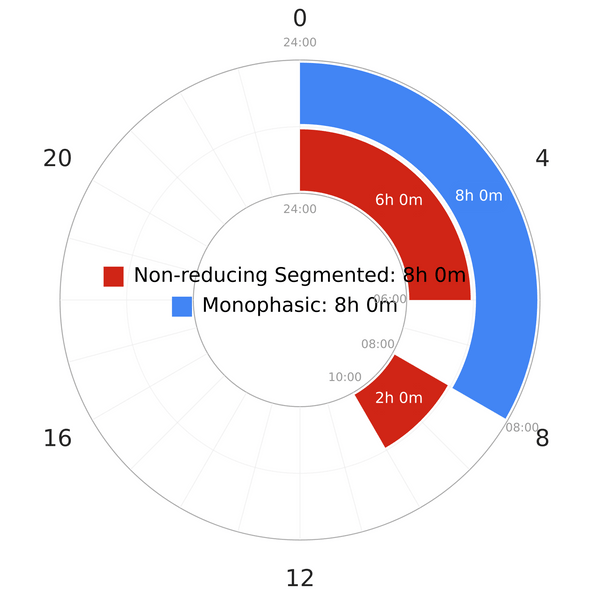 |
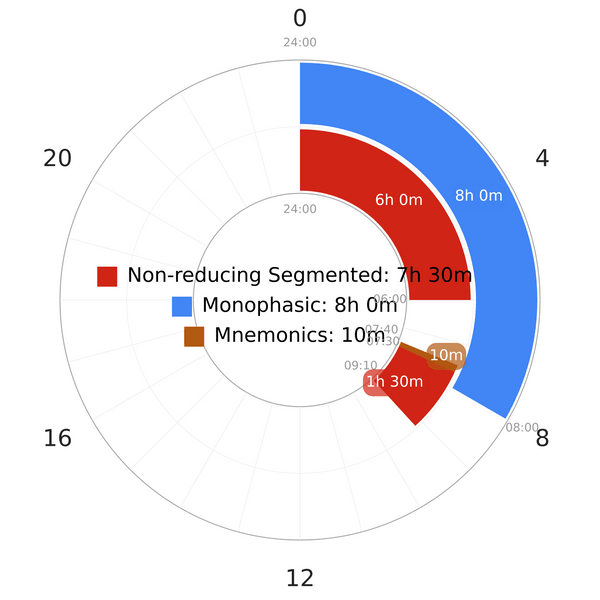 |
- Note that the duration of the first core sleep was only an approximation. This is because there were no direct specifics on the duration. In detail, participants slept two hours less than their normal sleep duration. Thus, the first core could last anywhere from 5 to 6 hours long.
- All in all, there was a massive increase of lucid dreams. Specifically, there were 10 times as many lucid dreams in the REM-peak sleep sessions as in the first core sleep.
- Version 1 totally outperformed any previous studies that used mental exercises to induce lucid dreams.
- For Version 2, only 8% of participants experienced lucid dreams in the first core sleep. Meanwhile, a whopping 67% ran into lucid dreams in the second core.
- Version 2 (possibly Version 1 as well) also surpassed interrupted and extended-interrupted monophasic sleep. In fact, some participants slept a normal nocturnal monophasic duration, practiced a mnemonic induction session and immediately returned to sleep for another 90 minutes. However, they still had fewer lucid dreams than long periods of wakefulness like on Segmented sleep.
Siesta Sleep
Similar to Segmented sleep, there was also an experiment on a type of Siesta sleep1.
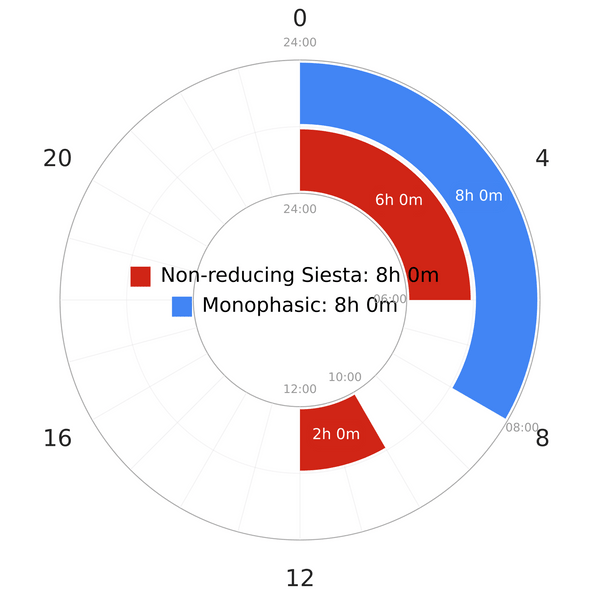
- Note that, though, the naming only follows the terminology of polyphasic schedule names on this website. As such, there is a distinction between the structure of this Siesta in-discussion and the previous Segmented versions.
- Even though there are only 4 hours of wakefulness between two cores, the second core locates around midday hours. Midday is also the timing of the circadian nadir, albeit somewhat earlier than a traditional “post-lunch” or default Siesta variant on the website. Hence, it is already out of REM peak, and acts like a daytime sleep session. Overall, it is more of a Siesta schedule than a Segmented schedule.
- Similar to Segmented, there are no direct specifics on the nocturnal sleep duration of participants. Thus, the assumption is that they slept anywhere between 5 and 6 hours at night. This is also based on the average mileage that no participants are short sleepers.
- Siesta sleep also scored high on lucid dreaming results; there was an increased likelihood of 10 times of lucid dream appearance in the daytime nap compared to the night core.
- Ultimately, the second core of Siesta, being later in the morning, trailed Segmented’s second core. There were fewer lucid dreams the later the daytime core. This difference was also statistically significant despite the mere 2 hours difference of the start time of the second core on both schedules.
Uberman Sleep
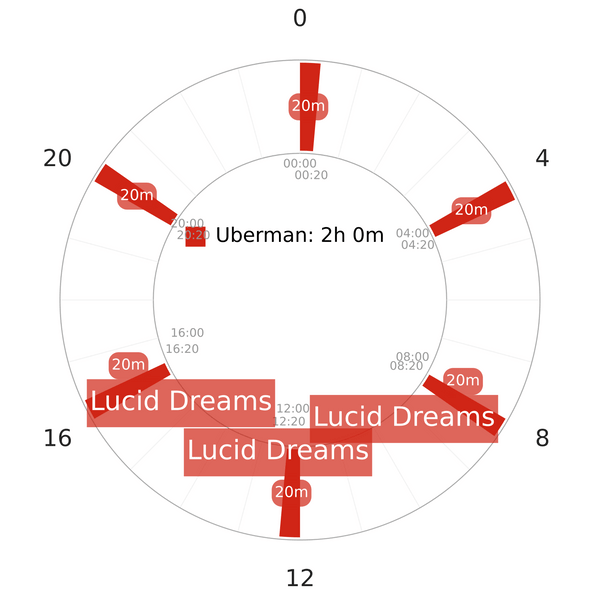
The newest research report of 2020 came in with Uberman sleep and other “similar polyphasic schedules”2. Because there is no specification on what constitute these schedules, the rest is speculative. Participants could have practiced Dymaxion sleep, Everyman 3, or just any nap-only variants. Given the long-lasting popularity of these polyphasic patterns, such speculations are reasonable.
- The Uberman sleepers stayed on the schedule from 3 to 44 days. On the other hand, the other group on “similar polyphasic schedules” spent 3-220 days on them before returning to monophasic sleep.
- As a whole, there was a skyrocketed number of lucid dreams on schedules like Uberman.
- There is a surprising contrast between these polyphasic schedules and monophasic sleep. There was a robust boost in absolute number of lucid dreams and the proportion of lucid dreams in relation to dream recall frequency.
- The polyphasic schedules in practice also transcended fragmented sleep in terms of lucid dreaming. However, fragmented sleep only denotes interrupted monophasic sleep, with small wakefulness periods in between each night sleep session.
- In general, participants reported 0.50 ± 0.92 lucid dreams per day on their polyphasic schedules. On the contrary, this number plummeted to 0.05 ± 0.09 after they terminated their polyphasic patterns.
- Note that there was no confirmation on “adapted” states of Uberman sleepers. Given their short stay on the schedule, it was unlikely they fully adapted to it.
Other Possible Polyphasic Schedules
Under the investigation on fragmented sleep2, many subjects woke up at night. Below are the results of this study:
- The majority of subjects had no more than 2 nocturnal awakenings at night. Though, a smaller minority reported 2-5 nocturnal awakenings.
- Lucid dreaming has a strong association with self-reported number of nocturnal awakenings.
- A partial correlation analysis demonstrated that there was no correlation between the amount of sleep fragmentation and lucid dreaming frequency. This notion suggests that the number of nocturnal awakenings did not increase or decrease how frequent a lucid dreaming experience would occur.
- A possible explanation is that awakening from NREM sleep would affect lucidity recall, while a REM awakening would improve the lucidity experience.
- Regardless, many participants experienced enhanced lucidity if their sleep is quite fragmented.
- Staying awake for at least 1 hour before sleeping again yields better lucid dreaming chances than only 20 minutes and 30 minutes1.
From this section, multi-core schedules like Dual Core, Tri Core or even the rare Quad Core are likely powerful candidates for lucid dreaming. However, this is only an indirect inference from the behavior of fragmented sleep, which is generally perceived as “bad”. The difference, however, is that these polyphasic schedules have a “purpose” of nocturnal awakening, to avoid the confusion with interrupted monophasic sleep. Each nocturnal awakening also lasts for mostly from ~2-4 hours depending on schedule.
Why Does Splitting Sleep Greatly Help with Lucid Dreaming?
Because we have just witnessed some research consensus on one of the biggest benefits of polyphasic sleeping, it is time to understand the “why”.
- Though not mentioned by the papers, one of the most convincing reasons is the REM peak. Indeed, once the previous sleep session has covered all or most SWS requirement of the day, REM sleep will become dominant around hours when its pressure is strongest. As the Part 1 post has explained, any polyphasic schedules can deliver strong lucid dreaming promises with a sleep block around the sunrise hours.
- Radically polyphasic schedules has more sleep sessions each day, and more extended wakefulness periods in between. Therefore, this trait allows for more REM episodes to follow the preceded wakefulness duration more closely than on extended monophasic sleep2. Though indirect, this notion also hints at the concept of REM sleep repartitioning on polyphasic sleep.
- The wakefulness periods and potential REM awakenings from each sleep may carry the “still-active” prefrontal cortex into a REM episode2. As a result, there is metacognitive processing that results in lucidity; meanwhile, during normal REM sleep, this process often shuts down.
- Sleep inertia from REM awakenings can carry into the wake period2. Thus, it is possible that this process maximizes the prefrontal cortex’s activity in the next REM-dominant sleep session.
What is the Best Polyphasic Schedule for Lucid Dreaming?
Now that we have analyzed polyphasic sleep and lucid dreaming, it is time for another huge question. Given the list of currently available polyphasic schedules, it is definitely overwhelming to determine which ones would be the best at their job. However, data from research in the previous section can tell which schedule(s) are more optimal than others.
Nevertheless, it is important to take into account personal sleep requirements and polyphasic experiences. This is because a Dual Core schedule may yield higher lucid dreaming frequency than an Everyman equivalent, or vice versa. Consequently, the only way to tell, is to log your dreams and try different polyphasic systems for yourself.
Biphasic Sleep – Is it “Bad” for Lucid Dreaming?
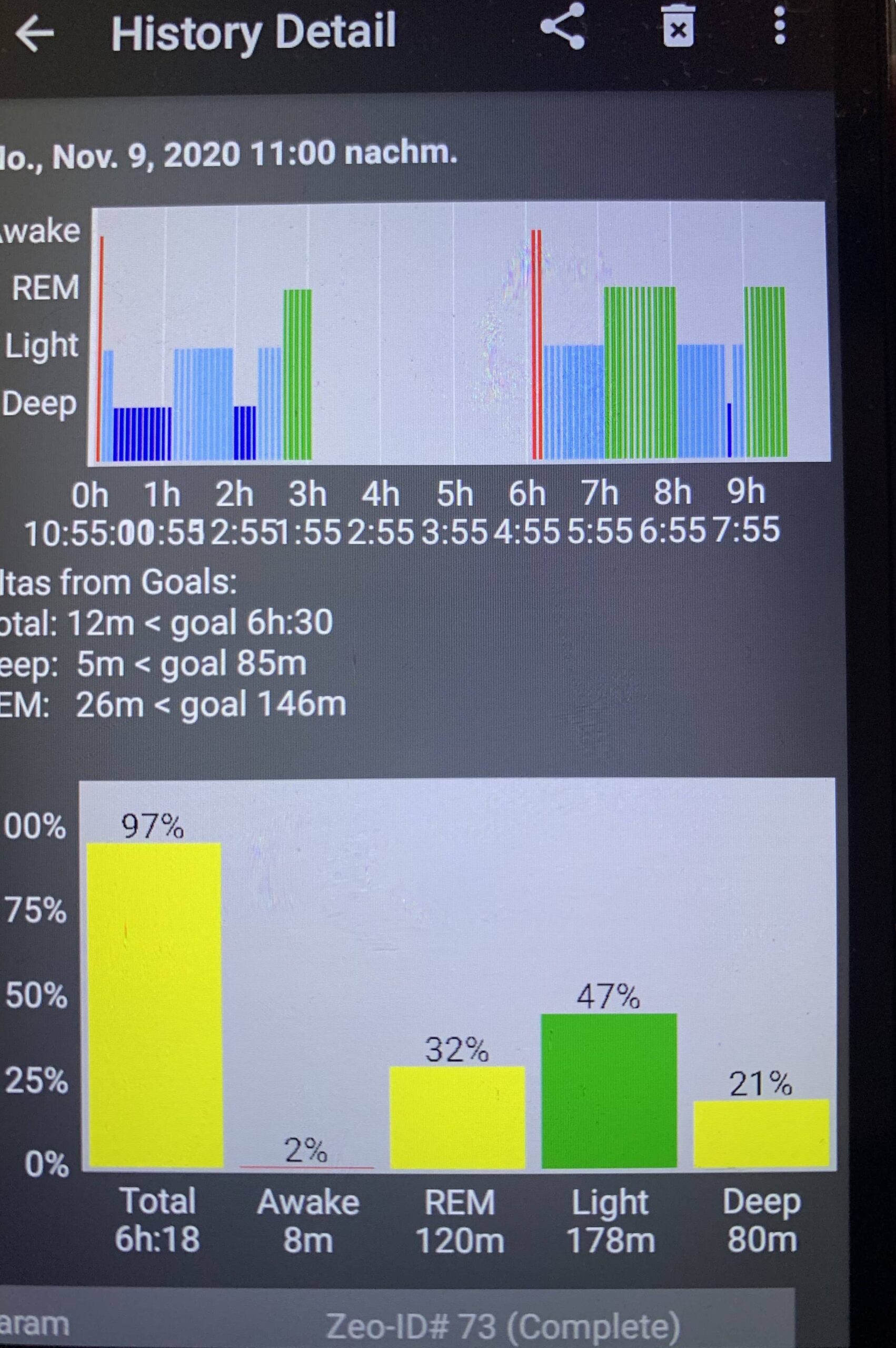
- Previous data show that Segmented sleep is the best among this schedule group. Next is a Siesta pattern with a long daytime sleep. Finally, we have Biphasic-X and Everyman 1.
- The community does have EEG readings on Segmented. As shown above, the second core really delivers.
- Siesta sleep usually has a core sleep around afternoon hours, which statistically have a lower amount of lucid dreams than Segmented sleep.
- Everyman 1’s nap is often too short. In addition, only roughly half of surveyed polyphasic sleepers manage to get REM in their nap. Considering the nap is also mostly in the afternoon, it is reasonable to expect a less stellar lucidity experience than Siesta and Segmented. E1 core is also mostly out of REM peak (except the late-core variant).
- Since longer sleep duration allows for more REM sleep, Biphasic-X’s usually shorter nap durations do not fare as well as other schedules. Given its non-reducing nature, raking in a lot of REM sleep in mere ~20-30m naps is largely unrealistic.
In other words, Biphasic sleep still has excellent potentials to tap into.
Everyman Sleep
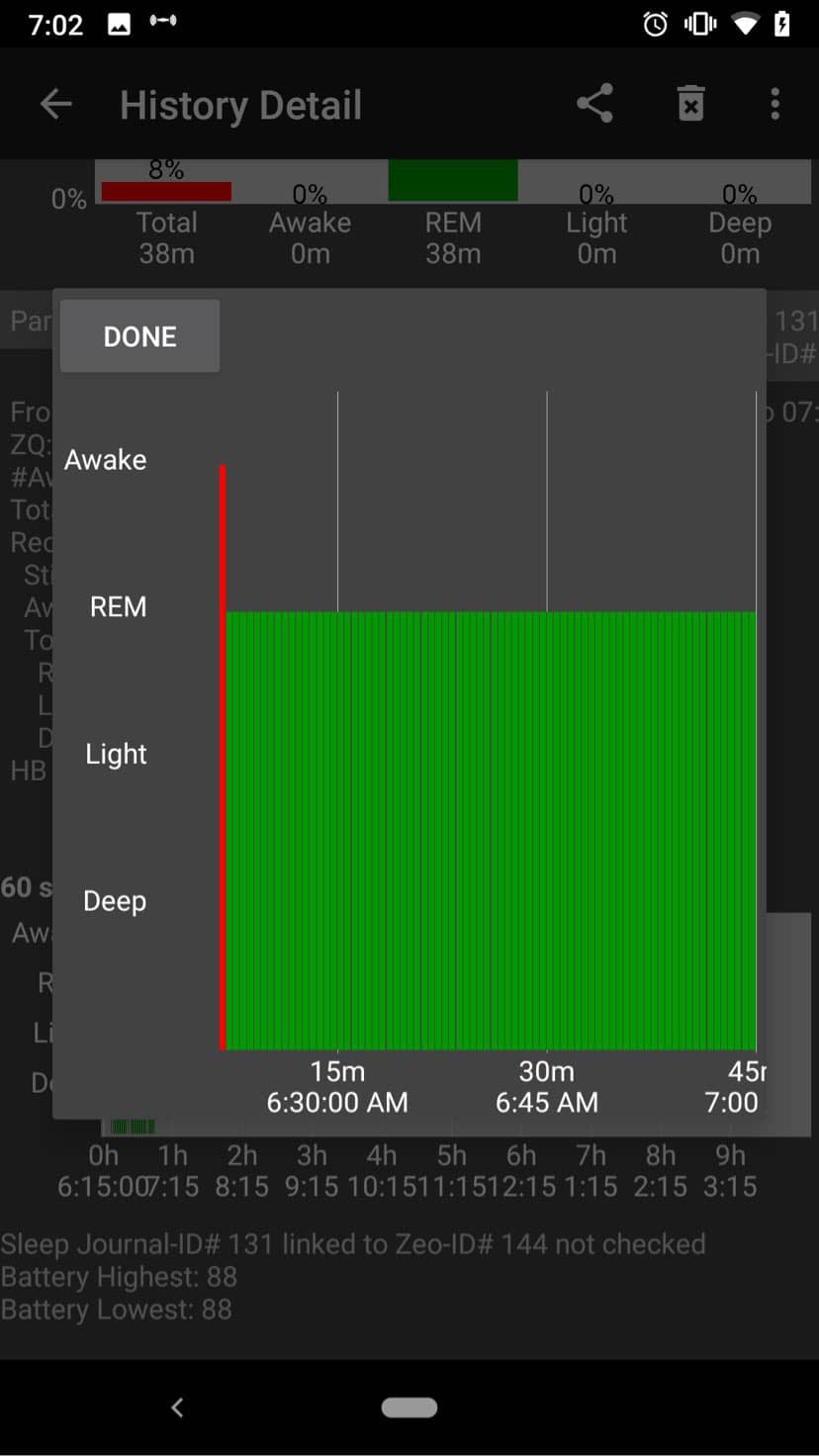
- These schedules typically have a nap (20m or a Pronap of up to ~45 minutes) around dawn. EEG readings have consistently shown that these naps are usually replete with REM sleep.
- Because the nap duration is short, there is usually a large percentage of REM sleep. Furthermore, the usual absence of SWS and very low amounts of light sleep can make for an otherworldly lucid exposure.
- The dawn nap on these schedules has seen numerous reports on lucid dreaming. It is, therefore, deservingly a sweet spot for lucid dreamers.
Multi-core Sleep
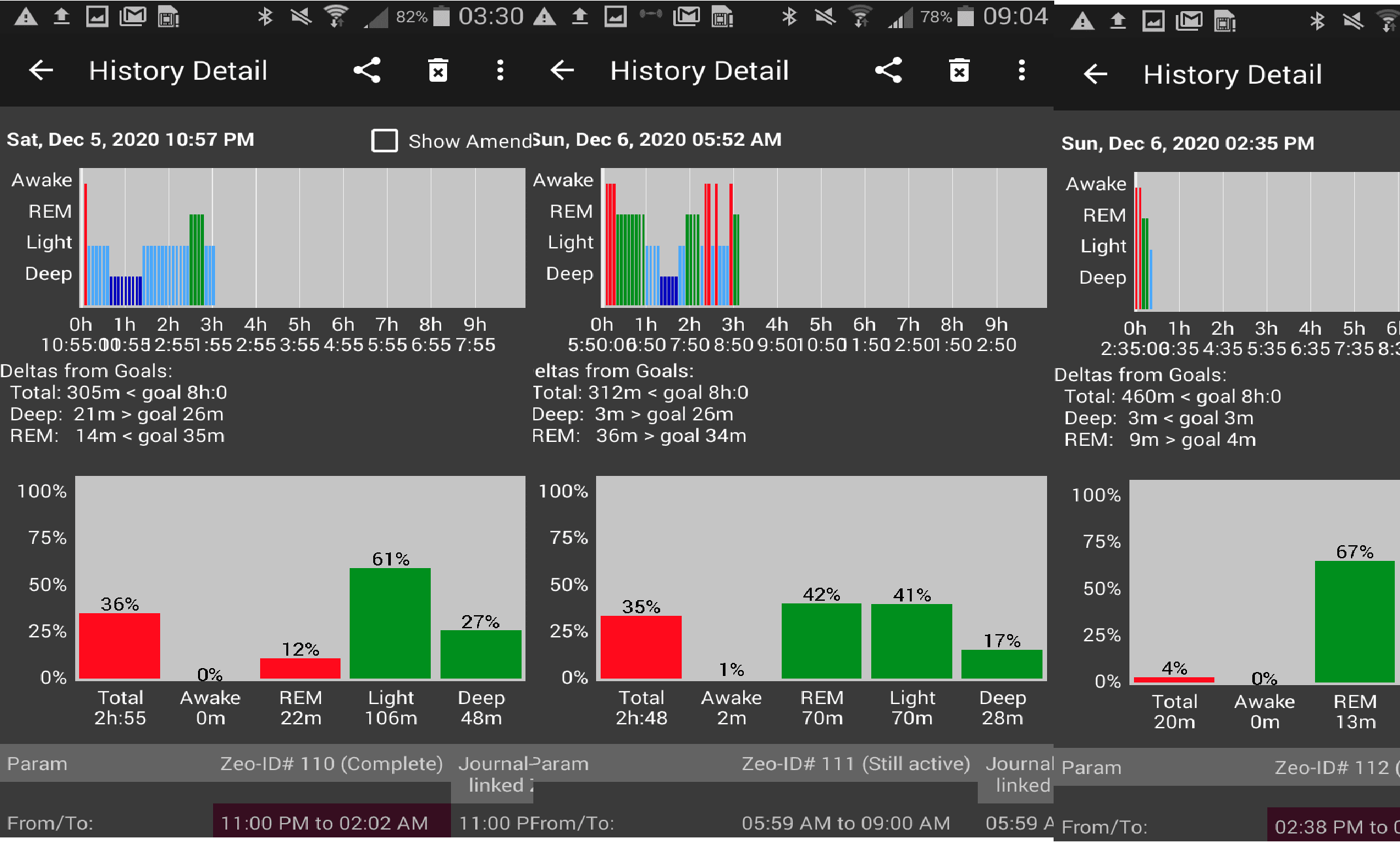
- Contrary to Everyman, these patterns often have a longer sleep session around dawn. It can last from 90 minutes to 3 hours.
- Because of the longer morning duration, there is also a higher percentage of light sleep and even SWS. However, the bulk of the sleep period still contains a majority of REM sleep.
- It is possibly more likely to wake from light sleep on a multi-core schedule than an Everyman schedule. Thus, this can affect recalling of lucid dreams. However, it is unclear why. A possible explanation is that the longer a sleep session, the more different sleep stages it will contain. This seems to make sense because a 3-hour core sleep, for example, will not contain purely 3 hours of REM sleep. A normal REM requirement only hovers around ~90-120 minutes each day.
- Regardless, multi-core schedules are still very solid contenders for optimizing lucid dreaming. Even the daytime naps can create lucid dreams, although less so than the REM core. The daytime nap of DC1-extended above shows a vibrant 13-minute REM period! However, this sleeper has elevated REM requirement.
- Like Everyman core, there is still a small chance to lucid dream during the first core sleep at earlier night hours.
Which is Better at Lucid Dreaming, Everyman or Multi-core Schedules?
With nap-only schedules not recommended to average sleepers, we are left with the question of the “very best” schedule. The short answer is, there is no such schedule. In fact, no schedules can be “the greatest of all time” when it comes to lucid dreaming.
Also, the good news is, there are healthy individuals who experience frequent SOREM naps without excessive daytime sleepiness symptoms3! This means that the naps and core(s) outside of the REM peak hours are capable of giving lucid dreams as well.
Factors
Moreover, the most optimal schedule(s) would be the one(s) that:
- Fit into your own timetable. It is obvious because setting out with a favorite Everyman 3 for 2 weeks but then having to change to another schedule is a bummer. Oftentimes, this negligence of personal timetable is common in beginners or those who have erratic daytime schedules.
- You can adapt to in the end. In the spectrum of long-term health and lucid dreaming, the former should be your priority. Apparently, only your attempts at different polyphasic patterns can tell the story. Lucid dreaming is great and all, but it should not be the “end-all-or-be-all” motivation for choosing polyphasic sleep. Therefore, picking E2 over E3, or Segmented over Uberman can make huge differences.
- You can stay on it for a long time to come. While this is not a requirement, sticking to one sleep schedule consistently without being bored is amazing! Not only do you know how long-term polyphasic sleep would turn out, but also, you do not have to adapt to other schedules again.
The uplifting news is, that you can already start lucid dreaming even during adaptation! They may naturally come, even if you do not plan to induce them.
With that in mind, even a fully adapted Segmented pattern can easily beat out an unadaptable Everyman 4, or Dymaxion. It is possible to lucid dream during AND after the adaptation phase. Thus, the longer you remain on one schedule, the more lucid dreams you will be able to experience! All that with the preservation of health.
Lucid Dreaming Mechanics
Recently, polyphasic sleepers in the Discord community have reported a diverse exposure with lucid dreaming. Biphasic sleep (barring Segmented) seems to be at a disadvantage compared to Multi-core and Everyman schedules. Regardless, there are a lot of unanswered questions to fully conclude which of these two systems are better at generating lucid dreams. For now, this area remains speculative and open for discussion.
Assume the core of a multi-core schedule and the nap of an Everyman schedule are at REM peak hours.
- Everyman proponents admit that a short nap is better for lucid dreaming. In their words, it is easier to enjoy a REM nap (to its name) with at least ~90% of the nap duration being REM sleep. Having light sleep and/or SWS in the nap or core would otherwise mess with the continuous flow of REM sleep. However, it has been shown that a dawn core can still yield REM wakes.
- In contrast, Dual Core enthusiasts claim that a longer core sleep would best the short nap. The reason is that there is simply a much higher amount of REM sleep in the core. This also implies that it may be possible to “dream longer” and experience more lucid dreams.
- A nap with mostly REM sleep may have a greater time dilation effect than a core sleep. This is because a core feels “deeper” and dreaming may be “less lucid”. In other words, there would be less lucid dreaming frequency in a core sleep.
- If a sleeper briefly transitions to light sleep just before awakening, with mostly REM sleep in a core before this point, does it affect lucid dreaming? Because a lot of reports say otherwise.
Lucid Dreaming Cautions
Aside from the new discovery on polyphasic sleep, it is necessary to pay attention to certain cautions below. Note that we are showing the cautions that are potentially relevant to polyphasic sleep only.
- Sleep disruption and poor sleep quality2,4. Specifically, it may increase sleep onset or cause abrupt awakenings during a core. Furthermore, these sudden transitions to wake can also disrupt REM and SWS. Furthermore, a sleep stage may be replaced entirely with a “hybrid” state (light sleep/semi-waking state). However, consistent polyphasic practice can circumvent this adverse effect. Thus, aiming for a moderate frequency of lucid dreaming would be preferable.
- Dissociative symptoms that may contribute to psychopathology5. Specifically, unusually heightened experiences may fragment memory consolidation. The encoding of memories can be confused by the sleep-wake transitions, especially on more extreme schedules. Most notably, it can also de-differentiate between the waking and dreaming state; for instance, experiencing more dream-like elements when awake, and wake features during sleep.
- However, lucidity’s intensity, but not frequency, has an inverse relationship with psychopathology6. It is also necessary to not consider lucid dreaming an ultimate tool of well-being. This is because the lucid dreams can either be negative or positive.
Regardless, all of these pointers require more research with polyphasic sleep as a lifestyle.
Conclusion
In sum, more research into more advanced polyphasic sleep forms is encouraging for the community. The eventual acknowledgement that polyphasic sleeping increases lucid dreaming chances is invaluable with research-based evidence. The community’s data further strengthens the notion as well.
Notwithstanding, it is critical to not look at extreme polyphasic schedules for the goal of lucid dreaming. The reports and data show that lucid dreaming is viable on the most basic polyphasic schedules. While it can be fabulous to achieve lucidity as an icing on the cake, lucid dreaming is not a metric to measure personal health. The priority for maintaining all vital sleep stages and attention to certain cautions should remind polyphasic sleepers of choosing a proper polyphasic schedule.
Main author: GeneralNguyen
Page last updated: 24 April 2021
Reference
- Gott, Jarrod, et al. “Sleep fragmentation and lucid dreaming.” Consciousness and Cognition 84 (2020): 102988. [PubMed]
- LaBerge, Stephen, Leslie Phillips, and Lynne Levitan. “An hour of wakefulness before morning naps makes lucidity more likely.” NightLight 6.3 (1994): 1-4.
- Bishop, Christopher, et al. “The frequency of multiple sleep onset REM periods among subjects with no excessive daytime sleepiness.” Sleep 19.9 (1996): 727-730. [PubMed]
- Vallat, Raphael, and Perrine Marie Ruby. “Is it a good idea to cultivate lucid dreaming?.” Frontiers in psychology 10 (2019): 2585. [PubMed]
- Van der Kloet, D., Merckelbach, H., Giesbrecht, T., & Lynn, S. J. (2012). Fragmented Sleep, Fragmented Mind. Perspectives on Psychological Science, 7(2), 159–175. doi:10.1177/1745691612437597. [PubMed]
- Aviram, Liat, and Nirit Soffer-Dudek. “Lucid dreaming: intensity, but not frequency, is inversely related to psychopathology.” Frontiers in psychology 9 (2018): 384. [PubMed]
